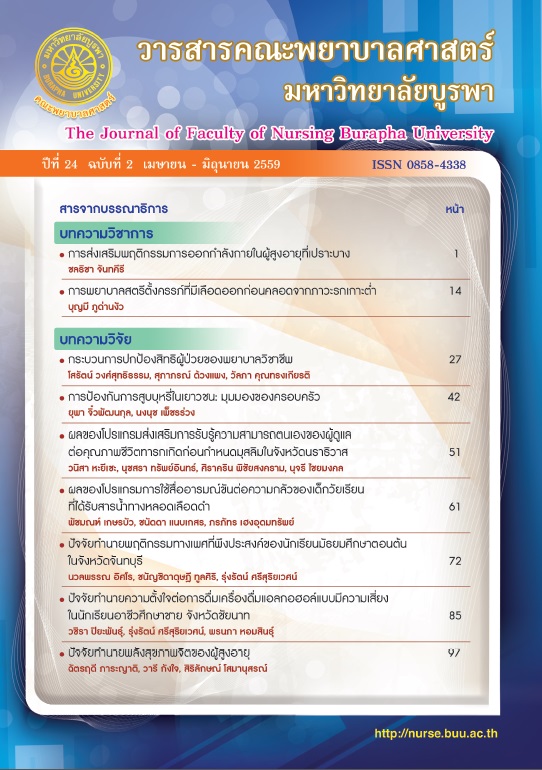คำสำคัญ:
โปรแกรมการใช้สื่ออารมณ์ขัน, ความกลัว, เด็ก, วัยเรียน, การได้รับสารน้ำทางหลอดเลือดดำ, Humor media program, fear, school children, intravenous infusionบทคัดย่อ
การวิจัยกึ่งทดลองแบบสองกลุ่มวัดผลก่อนและหลัง
การทดลองครั้งนี้ มีวัตถุประสงค์เพื่อศึกษาผลของโปรแกรม
การใช้สื่ออารมณ์ขันต่อความกลัวของเด็กวัยเรียนที่ได้รับ
สารน้ำทางหลอดเลือดดำ กลุ่มตัวอย่างเป็นเด็กวัยเรียนที่
ได้รับสารน้ำทางหลอดเลือดดำ ณ หอผู้ป่วยกุมารเวชกรรม
โรงพยาบาลพุทธโสธร จังหวัดฉะเชิงเทรา จำนวน 24 คน
คัดเลือกกลุ่มตัวอย่างด้วยวิธีการสุ่มอย่างง่ายเข้ากลุ่ม
ควบคุมและกลุ่มทดลอง กลุ่มละ 12 คน กลุ่มทดลองได้รับ
โปรแกรมการใช้สื่ออารมณ์ขัน กลุ่มควบคุมได้รับการ
พยาบาลตามปกติของหอผู้ป่วยกุมารเวชกรรม เครื่องมือที่
ใช้ในการวิจัยประกอบด้วยแบบสอบถามข้อมูลส่วนบุคคล
แบบประเมินระดับความกลัวโดยภาพการแสดงออกทาง
ใบหน้าและแบบสังเกตพฤติกรรมความกลัว ซึ่งมีค่าความ
เที่ยงโดยใช้สูตรสัมประสิทธิ์อัลฟ่าของครอนบาค ได้ .77
และ .81 ตามลำดับ และวัดอัตราการเต้นของชีพจรด้วย
เครื่องวัดอัตราการเต้นของชีพจร วิเคราะห์ข้อมูลด้วยการ
แจกแจงความถี่ ร้อยละ ส่วนเบี่ยงเบนมาตรฐาน และการ
ทดสอบค่าที
ผลการวิจัยพบว่า ค่าเฉลี่ยผลต่างคะแนนความกลัว
โดยภาพการแสดงออกทางใบหน้า พฤติกรรมความกลัว
และอัตราการเต้นของชีพจร ในกลุ่มทดลองน้อยกว่ากลุ่ม
ควบคุมอย่างมีนัยสำคัญทางสถิติ (p < .01) ผลการวิจัย
ครั้งนี้แสดงให้เห็นว่า พยาบาลที่ดูแลผู้ป่วยเด็กวัยเรียนควร
นำโปรแกรมการใช้สื่ออารมณ์ขันนี้ไปใช้เพื่อลดความกลัว
ให้กับผู้ป่วยเด็กวัยเรียนที่ได้รับสารน้ำทางหลอดเลือดดำ
----------------------------------------------
two-group pretest-posttest quasiexperimental
research aimed to determine effect
of humor media program on fear of school-age
children receiving intravenous infusion. Sample
included 24 school-age children who received
intravenous infusion at pediatric ward,
Buddhasothorn hospital, Chachoengsao province.
They were divided into control or experimental
groups by the use of simple random assignment.
Each group consisted of 12 school-age children.
The experimental group received humor media
program while the control group received a routine
nursing care. Research instruments consisted of
the demographic questionnaire, figures of facial
expression of fear, fear behavior observation and
pulse oximeter for pulse rate measure. The figures
of facial expression of fear and fear behavior
observation questionnaires had reliability of .77
and .81, respectively. Data were analyzed by using
frequency, percentage, standard deviation and
t-test.
Results revealed that after receiving the
intervention program, there were statistically
significant mean differences of fear rating, fear
behavior and pulse rate between experimental
and control groups (p < . 01 ). The study suggested
that nurses who take care school-age children
should apply this humor media program for
reducing fear among school-age children who
receive intravenous infusion.





